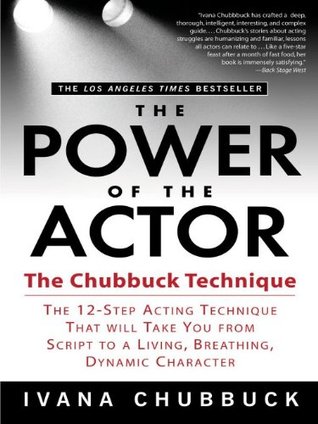Kindle Notes & Highlights
The choices you make for your DOINGS flesh out your character’s neurosis, social background, educational background, financial status, and how they really feel about the other character.
Your choice of props/ activities should be appropriate to the character’s life (psyche, economic background, present job status, history, sexual predilection, geographical location, time period, etc.).
Whatever you choose to do, hiding your animosity with DOINGS gives us more information about what you’re really feeling and how you deal with those feelings.
A DOINGS-driven approach might be to eat Girl Scout cookies (a seemingly innocent act) while you threaten the other character with heinous, unspeakable acts of torture.
DOINGS allows for other possibilities, which disarms and confuses the victim about what’s going to happen next. Not knowing what your predator is going to do moment to moment is much more frightening.
DOINGS Must Further Your SCENE OBJECTIVE
When you are going after your SCENE OBJECTIVE and really need reactions from the other person, it creates unconscious behavior.
all con games involve aspects of wanting and needing to feel powerful.
who-am-I of the character, which is essential in making DOINGS choices.
The writer may have put particular DOINGS in the script, but these are often just suggestions.
Don’t just use DOINGS where they’re indicated in the script. The more DOINGS you have, the more behavior can emerge.
You must personalize your DOINGS so they mean something special to you.
use your SUBSTITUTION and endow what’s pictured in the photo with a person that makes emotional sense to the scene and you.
you’d endow the drink in front of you with the vice you do have
you’d then endow the particular music playing with that special song that you shared with your SUBSTITUTION for the scene. Or you might endow the CD with the music that reminds you of emotionally charged past events that match up to the feelings you’re supposed to have, as supplied by the script’s text.
Most characters have a defining phobia or neurosis. If not, then it’s up to the actor to come up with something that makes the character stand out.
DOINGS help to create a deep, visual understanding of how and why a character’s neurosis or psychosis exists.
No matter what your character is addicted to, addicts take huge risks—robbing banks, killing, having multiple affairs, and being willing to lose a friend, family or a job just to get their drug. If you’re playing an addict, your DOINGS should consider and reflect these extreme behaviors.
I. noun—[usu. in sing.] 1. a particular way or method of doing something, especially one that is characteristic or well-established • the volunteers were instructed to buy specific systems using our usual modus operandi—anonymously and with cash. 2. the way something operates or works.– origin Latin, literally ‘way of operating.’
Mental and chemical imbalances are not in our control. They are usually OBSTACLES, additional hurdles to jump over in attaining and winning the SCENE OBJECTIVE.
A modus operandi (how we operate) is a set of behaviors that we use to help us to achieve and win our goals.
examples of classic jobs that are represented again and again in movies, television and theater, and the DOINGS that can be used.
Use your imagination to come up with DOINGS choices that are career appropriate.
Remember to also consider the neurosis and the M.O. of the character when making y...
This highlight has been truncated due to consecutive passage length restrictions.
In addition to considering your character’s neuroses, M.O. and career, you should always consider the space you are in.
Inside place DOINGS will be determined by the space itself and what props and furniture might naturally exist within that environment.
You can bring personal props or talk to the prop master and director about providing the props you need.
how to think about a character’s DOINGS—by considering your character’s SCENE OBJECTIVE, neurosis, career, M.O. and locale.
Finding the appropriate doings is a game of mix and match.
DOINGS are handwritten on the left side of the dialogue (to avoid confusion with BEATS and ACTIONS, which are always written on the right).
Always handwrite your DOINGS choices in the general vicinity of where in the script you want to accomplish your DOINGS.
The DOINGS you write on your script are merely ideas—you can veer off to other DOINGS that are available on the set.
There will not be a DOINGS for every line or BEAT because DOINGS take time to accomplish.
DOINGS further intensify the scene’s arc as well as supports and strengthens the character’s (and actor’s) journey, which is initiated by the SCENE OBJECTIVE.
DOINGS are important because behavior rarely happens by just standing there and saying the words.
While INNER OBJECTS are the pictures and images in our minds that are attached to the words in the script, INNER MONOLOGUE is actual dialogue—words and sentences going on inside our head.
The tools complement each other, providing your brain with pictures (INNER OBJECTS) and words (INNER MONOLOGUE) that make your character’s thinking truly human.
Using INNER MONOLOGUE in conjunction with INNER OBJECTS serves to accurately duplicate the way a real person’s thought process works.
INNER MONOLOGUE is defined paranoia: all the things you can’t say because it will make you seem wrong, vulgar, mean, insecure, crazy, stupid or prejudiced.
INNER MONOLOGUE is the unspoken communication between people.
Write your INNER MONOLOGUE in a way that establishes intercommunication with you and the other character (s). To do this, use the word “you” when addressing your thoughts to the other person, instead of expressing your thoughts to yourself by using “he” or “she.”
“Why are you looking at me so weirdly? You must think I’m crazy. . . .”
This interactive INNER MONOLOGUE will help to produce behavior,


